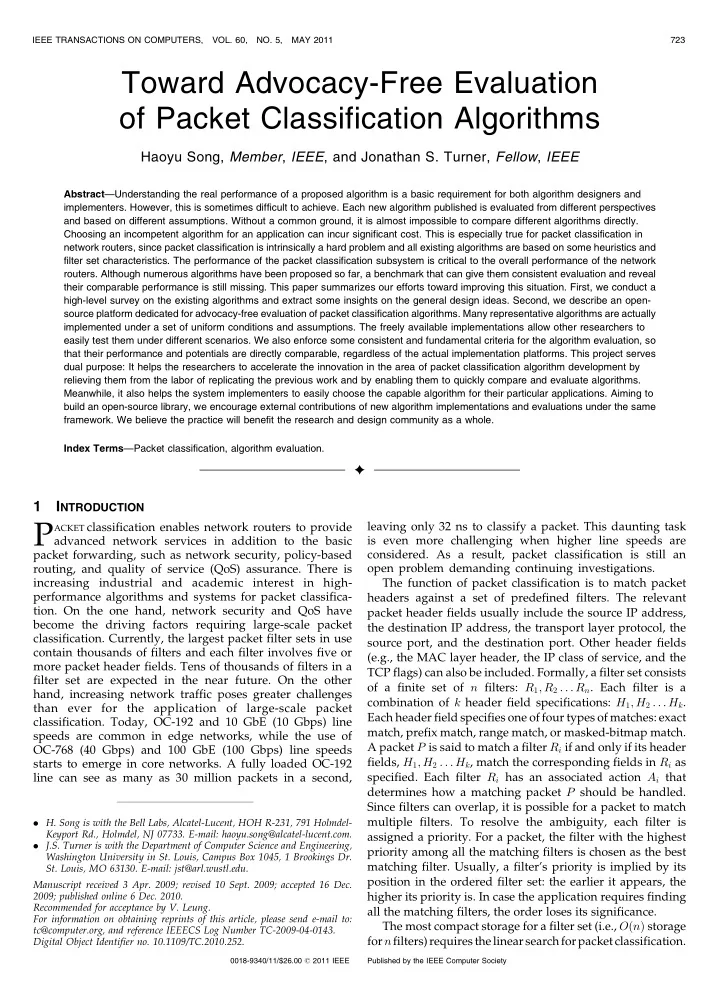

IEEE TRANSACTIONS ON COMPUTERS, VOL. 60, NO. 5, MAY 2011 723 Toward Advocacy-Free Evaluation of Packet Classification Algorithms Haoyu Song, Member , IEEE , and Jonathan S. Turner, Fellow , IEEE Abstract —Understanding the real performance of a proposed algorithm is a basic requirement for both algorithm designers and implementers. However, this is sometimes difficult to achieve. Each new algorithm published is evaluated from different perspectives and based on different assumptions. Without a common ground, it is almost impossible to compare different algorithms directly. Choosing an incompetent algorithm for an application can incur significant cost. This is especially true for packet classification in network routers, since packet classification is intrinsically a hard problem and all existing algorithms are based on some heuristics and filter set characteristics. The performance of the packet classification subsystem is critical to the overall performance of the network routers. Although numerous algorithms have been proposed so far, a benchmark that can give them consistent evaluation and reveal their comparable performance is still missing. This paper summarizes our efforts toward improving this situation. First, we conduct a high-level survey on the existing algorithms and extract some insights on the general design ideas. Second, we describe an open- source platform dedicated for advocacy-free evaluation of packet classification algorithms. Many representative algorithms are actually implemented under a set of uniform conditions and assumptions. The freely available implementations allow other researchers to easily test them under different scenarios. We also enforce some consistent and fundamental criteria for the algorithm evaluation, so that their performance and potentials are directly comparable, regardless of the actual implementation platforms. This project serves dual purpose: It helps the researchers to accelerate the innovation in the area of packet classification algorithm development by relieving them from the labor of replicating the previous work and by enabling them to quickly compare and evaluate algorithms. Meanwhile, it also helps the system implementers to easily choose the capable algorithm for their particular applications. Aiming to build an open-source library, we encourage external contributions of new algorithm implementations and evaluations under the same framework. We believe the practice will benefit the research and design community as a whole. Index Terms —Packet classification, algorithm evaluation. Ç 1 I NTRODUCTION P leaving only 32 ns to classify a packet. This daunting task ACKET classification enables network routers to provide is even more challenging when higher line speeds are advanced network services in addition to the basic considered. As a result, packet classification is still an packet forwarding, such as network security, policy-based open problem demanding continuing investigations. routing, and quality of service (QoS) assurance. There is increasing industrial and academic interest in high- The function of packet classification is to match packet performance algorithms and systems for packet classifica- headers against a set of predefined filters. The relevant tion. On the one hand, network security and QoS have packet header fields usually include the source IP address, become the driving factors requiring large-scale packet the destination IP address, the transport layer protocol, the classification. Currently, the largest packet filter sets in use source port, and the destination port. Other header fields contain thousands of filters and each filter involves five or (e.g., the MAC layer header, the IP class of service, and the more packet header fields. Tens of thousands of filters in a TCP flags) can also be included. Formally, a filter set consists filter set are expected in the near future. On the other of a finite set of n filters: R 1 ; R 2 . . . R n . Each filter is a hand, increasing network traffic poses greater challenges combination of k header field specifications: H 1 ; H 2 . . . H k . than ever for the application of large-scale packet Each header field specifies one of four types of matches: exact classification. Today, OC-192 and 10 GbE (10 Gbps) line match, prefix match, range match, or masked-bitmap match. speeds are common in edge networks, while the use of A packet P is said to match a filter R i if and only if its header OC-768 (40 Gbps) and 100 GbE (100 Gbps) line speeds fields, H 1 ; H 2 . . . H k , match the corresponding fields in R i as starts to emerge in core networks. A fully loaded OC-192 specified. Each filter R i has an associated action A i that line can see as many as 30 million packets in a second, determines how a matching packet P should be handled. Since filters can overlap, it is possible for a packet to match multiple filters. To resolve the ambiguity, each filter is . H. Song is with the Bell Labs, Alcatel-Lucent, HOH R-231, 791 Holmdel- Keyport Rd., Holmdel, NJ 07733. E-mail: haoyu.song@alcatel-lucent.com. assigned a priority. For a packet, the filter with the highest . J.S. Turner is with the Department of Computer Science and Engineering, priority among all the matching filters is chosen as the best Washington University in St. Louis, Campus Box 1045, 1 Brookings Dr. matching filter. Usually, a filter’s priority is implied by its St. Louis, MO 63130. E-mail: jst@arl.wustl.edu. position in the ordered filter set: the earlier it appears, the Manuscript received 3 Apr. 2009; revised 10 Sept. 2009; accepted 16 Dec. 2009; published online 6 Dec. 2010. higher its priority is. In case the application requires finding Recommended for acceptance by V. Leung. all the matching filters, the order loses its significance. For information on obtaining reprints of this article, please send e-mail to: The most compact storage for a filter set (i.e., O ð n Þ storage tc@computer.org, and reference IEEECS Log Number TC-2009-04-0143. for n filters)requiresthelinearsearchforpacketclassification. Digital Object Identifier no. 10.1109/TC.2010.252. 0018-9340/11/$26.00 � 2011 IEEE Published by the IEEE Computer Society
Recommend
More recommend